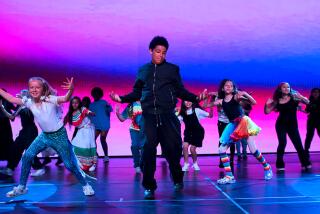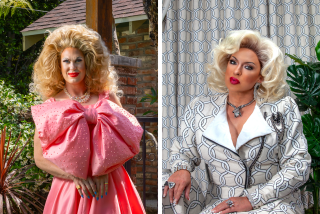A Dream Choreographed by Fosse
NEW YORK — When 50 hopeful young dancers audition for Gwen Verdon and a panel of high-profile dance professionals next Sunday at UCLA, they will be helping to fulfill a vision cherished by the late Bob Fosse, the celebrated choreographer-director who was married to Verdon and who guided her to many of her most memorable performances. Two of the auditioning dancers will be selected as the first recipients of the annual Bob Fosse Scholarships, which will cover the costs of a wide-ranging, full-time year of dance study.
It has taken nine years for Verdon to locate a venue and format for these scholarships, a project that is clearly as important to her as it was to Fosse, who died in September 1987. In his will, he left a portion of his money to be used to train young dancers.
For a while, Verdon, who shot to fame in such celebrated Fosse musicals as “Damn Yankees” (1955), “Redhead” (1959), “Sweet Charity” (1966) and “Chicago” (1975), tried to make his dream of a scholarship program a reality through her own efforts. “I was still working, so I couldn’t keep going out and auditioning people or going around to all the schools to watch classes,” she explained during a recent interview at a dance studio in midtown Manhattan. “I couldn’t do it alone, but there was this money sitting there.”
She found what she considers to be the ideal partner in the Los Angeles Dance Foundation, a 5-year-old nonprofit organization with a strong educational focus. Verdon has endowed the scholarships in Fosse’s name, and the foundation will coordinate and administer the program. “It’s a new venture for us, but it’s remarkably close to what our original plan was,” notes LADF President Grover Dale, a well-known film and Broadway dancer-choreographer.
Exposing young dancers to a wide range of dance styles and encouraging them to explore each in depth is central to Verdon’s idea of what these scholarships should accomplish. Excellence is the goal. “Bob was very concerned with how dancers are being trained,” she said. “There’s no place in California for young dancers to get the kind of rounded dance education that you get in New York, where there are all kinds of dance classes available within a subway ride of each other.”
Verdon’s own experience taught her the value of learning different ways of moving rather than focusing too narrowly on one style. “You can’t believe the things we studied when I was a kid,” she remarked. “We even learned how to juggle! I studied Spanish dancing, flamenco, ballroom, East Indian, Afro-Cuban; you name it!” That rich background served her well when she appeared in musicals and films choreographed by Jack Cole and Fosse, both of whom drew on a rich array of movement styles, from ballet to ethnic, in their work.
She wants to see today’s young dancers become equally aware of and open to a range of movement possibilities, and hopes the scholarship program will help to broaden those who may become the performers of tomorrow. “It aims to open them up to something other than rap dancing or strictly ballet. They tend to go for extremes rather than being able to put it all together,” she said.
The scholarships are available to intermediate-level dancers who are between 16 and 21. Auditioners have been culled from applications submitted in advance, and Verdon and the scholarship program’s four Los Angeles directors--Sally Goldin (a former Broadway dancer), Rebecca Wright (former Joffrey and ABT dancer), and Bill and Jacqui Landrum (media dancers/choreographers)--will make the final selection. The recipients will then shape their own curriculum from the classes offered by eight Southern California dance studios and schools.
“We will customize the program for each recipient, according to individual needs, and each will be assigned a mentor,” Dale explained. “All the major dance studios have agreed to be part of the program, so this is a real effort at building community.”
Although they bear Fosse’s name, the scholarships are not particularly aimed at preparing dancers for a musical theater career. Dale emphasizes that the recipients will be encouraged to pursue their own interests. “If they are leaning toward a concert career, we will encourage local dance companies to accept them as apprentices,” he says.
In the course of their October to June study, the scholarship dancers will also have a chance to work on Fosse material, since veteran Fosse interpreters such as Chita Rivera and Ann Reinking (another former Fosse wife) will offer master classes when they come through Los Angeles. Verdon plans to check in every three months to evaluate their progress. “I’ll see what’s going on with other dancers who are studying in the classes and get a head start on what might happen next year.”
Verdon is busy on a variety of fronts these days. She recently completed filming on “Marvin’s Room,” based on the late Scott MacPherson’s acclaimed off-Broadway play. The film, in which Verdon plays Ruth, the title character’s sister, was directed by Jerry Zaks and also stars Meryl Streep, Diane Keaton, Hume Cronyn and Leonardo DiCaprio; it opens in October. A few days after this interview, Verdon was due to fly to Calgary to finish work on an upcoming television movie.
Also occupying her time is another dance undertaking, again dedicated to her late ex-husband. For now, it’s called the Fosse Project, and Verdon is its artistic advisor and, clearly, its guiding spirit. It is an evening’s worth of Fosse choreographic highlights, selected from the musicals, television programs and films he worked on in the course of his more than 32-year career. This month, the project’s 28 dancers will be rehearsing in Toronto and presenting a workshop. If all goes well, the full production will eventually arrive on Broadway.
Verdon had stopped by the Manhattan studio on this sweltering summer afternoon to scrutinize an excerpt from “New Girl in Town,” a 1957 show in which she starred (and won a Tony Award). No detail went unnoticed as she and director Chet Walker had the eight dancers repeatedly go through a section from the show’s first-act finale.
All the dancers wore black, and the leggy women clearly were trying for the distinctive slinky Verdon look of the 1950s. As she watched one dancer performing the steps she herself had performed nearly 40 years ago, Verdon reminded her that “there’s a calm elegance to it.” She watched run-throughs of a sequence of high stag leaps until she was sure that all eight were launching their leaps on the same count. She also made certain that the pattern the two crossing lines of dancers made was just as she remembered it.
“For some reason, I can always remember the dances, even from shows I did 40 years ago,” Verdon said when she sat down to talk after the rehearsal. “I guess that’s because I always did each show for about two years. So if you play the music, it just comes back to me.”
The fact that it has taken three years to prepare the dancers who will do the Fosse Project’s workshop has underlined for Verdon that the kind of thorough training the Fosse scholarships will make possible is crucial. “If we get to Broadway with this, and they want to create a touring company, we’ll need to have dancers who can do this,” she said.
Both she and Dale have a long-range commitment to something even bigger than the scholarship program. They would like to create in Los Angeles a multifaceted dance training facility, with lots of options under one roof. “We hope to have a building where all of the styles and techniques will be available, where the students can just go from one floor to another,” Verdon said.
Even as she watches over and maintains the heritage she helped create, she is clearly just as concerned with making sure opportunities are there for the dancers of the future.
More to Read
The biggest entertainment stories
Get our big stories about Hollywood, film, television, music, arts, culture and more right in your inbox as soon as they publish.
You may occasionally receive promotional content from the Los Angeles Times.










